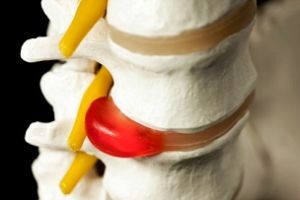 The well-known term "neuralgia" is treated only as the defeat of peripheral nervous beams, characterized by acute attacks of burning pain in the zone of innervation. In medical practice, neuralgia of the cranial, spinal, and femoral nerves are distinguished.
The well-known term "neuralgia" is treated only as the defeat of peripheral nervous beams, characterized by acute attacks of burning pain in the zone of innervation. In medical practice, neuralgia of the cranial, spinal, and femoral nerves are distinguished.
Spinal intercostal neuralgia( thoracalgia) is a condition in which the peripheral nerves leaving the spine are compressed in the chest region.
More often, such an ailment can occur in older people against the background of age-related changes. Meanwhile, the emergence of characteristic pain is also possible in children with intensive skeleton formation.
In men, pain is localized in the lower part of the ribs, whereas in women - mainly in the heart.
 You may be interested in a set of exercises for scoliosis. Scoliosis can be prevented at an early age.
You may be interested in a set of exercises for scoliosis. Scoliosis can be prevented at an early age. Sciatica is an inflammation of the sciatic nerve. Here, read about the treatment of this problem.
Contents of the article
- The main causes and prerequisites of the disease
- Symptoms and manifestations of intercostal thoracic
- What does the diagnosis of the disease involve?
- A modern approach to the treatment of intercostal thoracalgia( neuralgia)
- Folk methods of healing intercostal thoracicgia( neuralgia)
- How to prevent the development of intercostal neuralgia?
The main causes and prerequisites for the development of the disease
The cause of the emergence of permanent and periodic( paroxysmal) pain sensations is a thin intercostal nerve reflexively squeezed / squeezed between the muscle fibers.
A burning pain, numbness or tingling, a sharp pain spreads throughout the chest at a time when impulses run through the nerves in the spine.
The prerequisites for the development of intercostal neuralgia become:
- severe stress and hypothermia;
- intoxication;
- rib injuries, which are the result of severe physical overloads;
- inflammatory diseases( including malignant ones);
- pathological changes in the spine( eg, osteochondrosis).
Despite some similarity of symptoms, the disease should be distinguished from neuritis, since there is no inflammation in intercostal neuralgia, the sensitivity of the skin is not compromised while maintaining muscle activity.
Increased pain in the chest can be caused by excessive tone of certain muscles - the shoulder, shoulder blade or extensors of the back.
Symptoms and manifestations of intercostal thoracology
The main symptom of thoracology is a sharp pain in the intercostal space, which is easily detected by palpation. The pain is localized, as a rule, to the right or to the left.
The patient is irritated, and sneezing and coughing causes him severe pain.
At the onset of atrophic changes in the nerve root, the pain goes away, gradually giving way to a feeling of heaviness in the chest, which indicates the neglect of the disease.
In addition, the patient decreases the volume of filling of the lungs and there is a shallow breathing.
In most cases, the onset of neuralgia is preceded by a short muscle spasm that promotes immediate irritation of nerve endings and the appearance of severe pain syndrome.
What does the correct diagnosis of the disease involve?
Diagnosis of the disease begins with a simple neurologic examination.
Based on typical complaints from the patient, the neurologist performs a differential examination of the chest in order to detect( exclude) respiratory diseases.
The left-sided pain localization testifies to the necessity of examining the heart function with the help of an electrocardiogram( ECG) to exclude pathologies( angina pectoris, ischemia).
In addition, X-rays of the thoracic spine are performed.
As additional measures may be required electroneurography, MRI, computed tomography and other examinations.
The modern approach to the treatment of intercostal thoracalgia( neuralgia)
As the statistics show, the method of treating neuralgia depends on the nature of nerve damage and the degree of neglect of the disease.
In this regard, the treatment of intercostal neuralgia can drag on for many months, especially if the disease is started.
After the diagnosis and the causes of the disease, the neurologist prescribes a comprehensive treatment.
If neuralgia is characterized by the secondary signs, then its treatment should be carried out taking into account the underlying disease or after reaching its remission.
As the main methods of drug treatment, the patient is prescribed:
- local painkillers( ointments);
- non-steroidal anti-inflammatory drugs( in the form of tablets or injections);
- vitamin therapy - vitamins of group B are appointed;
- antidepressants and relaxants.
In case of complete absence of any result when using drugs, the neurologist can recommend an operative intervention, the purpose of which is to remove the tissues clamping the nerve process or narrowing the nerve-conduction channel.
Traditional methods of healing intercostal thoracalgia( neuralgia)
In non-traditional medicine there are many recipes that produce an analgesic effect.
Here are some of them:
- Prescription No. 1. Freshly squeezed radish juice is rubbed in circular motions into the skin in the area of the compressed nerve.
- Recipe No.2.Brew 1-2 tbsp.l.flowers immortelle sandy in 0.5 liters of boiling water. Boil the broth, drink in small doses.
- Recipe # 3.Make a decoction of chamomile, taking 4 tbsp.l.flowers per 1 tbsp.hot water. Strain and drink 3 r.a day, but definitely after a meal.
- Recipe # 4.Infuse 4 tbsp.l. Sage in a glass of warm water for 1 hour to fill, then drain. Pour the resulting infusion into a bath( 37 ° C) and add 4 tbsp.l.rich in sea salt minerals. Take a therapeutic bath for the night, the course of treatment is 10 procedures.
- Recipe # 5.Prepare a decoction of peppermint from 1 tbsp.l.leaves on 200 ml of boiling water. Ingestion of 100 ml( in the morning on an empty stomach and at night).
- Recipe # 6.½ tsp.orange peel and ½ tsp. Melissa mixed and steamed in boiling water( 200 ml), then insist for 30 min.and strain. The course of procedures - within 1 month take at least 3 times a day for a third of the glass, previously adding 1 tsp.honey and tincture of valerian.
How to prevent the development of intercostal neuralgia?
 As a preventive measure of intercostal neuralgia, it is necessary to avoid the hypothermia of the body in every possible way, and also to seek medical help in time in case of catarrhal diseases.
As a preventive measure of intercostal neuralgia, it is necessary to avoid the hypothermia of the body in every possible way, and also to seek medical help in time in case of catarrhal diseases.
The most effective measures of disease prevention are the following:
- acupuncture acupuncture - 3 courses are necessary with a break of 2 months;
- manual therapy - allows you to restore the position of the cervical and thoracic vertebrae, which relieves pain in this area of the spine;
- therapeutic massage with warming creams and ointments;
- "shiatsu" - Japanese "pressing" massage, the object of which is the active points associated with the affected area of the intercostal space;
- osteopathy is a method of anatomical chest reconstruction, which improves blood flow and lymph circulation, etc.;
- medical and physical training.
From all of the above it follows that intercostal neuralgia is an insidious disease, often "masked" under the symptoms of other diseases.
The launched form of the disease will require maximum energy during the treatment.
A few more recommendations for people suffering from this ailment.



